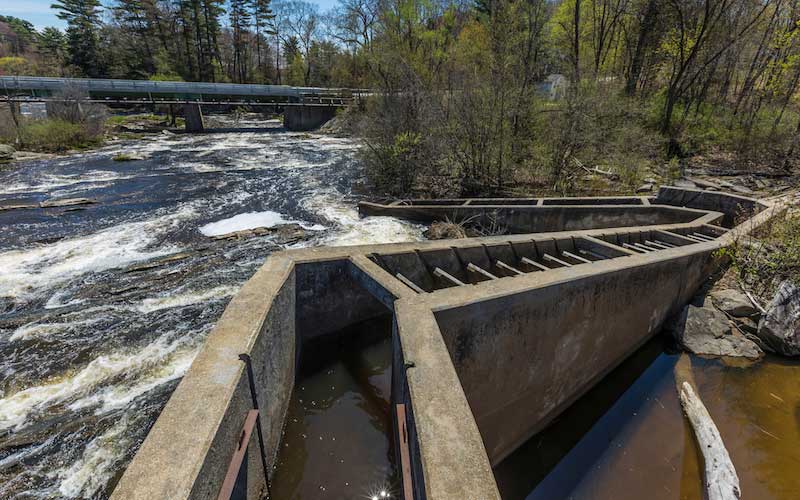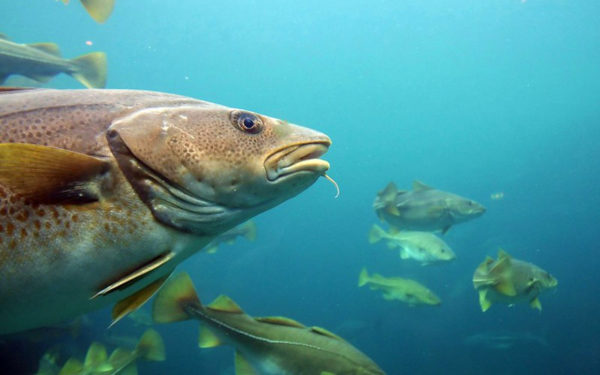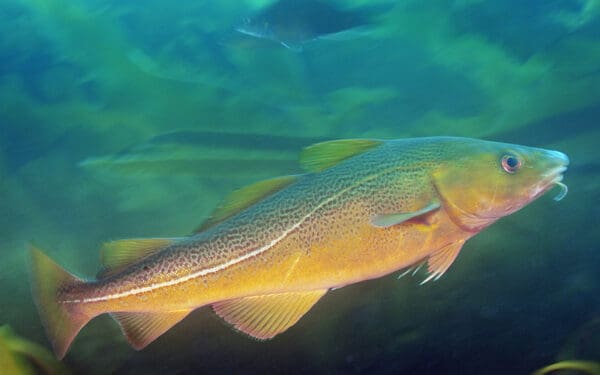
A fish ladder on the Royal River in Yarmouth, Maine, has been blocked for years, preventing fish from moving upriver to spawn. Photo: EcoPhotography
The Royal River runs about 30 miles from its headwaters in New Gloucester, Maine, to its outlet in Casco Bay in Yarmouth. Like many of New England’s coastal rivers, the Royal drove vital economic growth during the region’s industrial era, when dams built along its route harnessed water to power mills, tanneries, and more.
While those industries are gone, two of the Royal’s dams remain: the East Elm Street and Bridge Street dams, both in Yarmouth. They’re old and in disrepair and are wreaking havoc on the local ecosystem. The fish ladders built to allow native fish like river herring and shad to move upriver every spring to spawn have been blocked for years, causing precipitous drops in the populations of those species in the Royal’s watershed.
A collapse in river herring and shad is not an isolated event – healthy populations of these fish boost the entire ecosystem as well as Maine’s marine economy. That’s why CLF is taking action, putting the owner of the Sparhawk Mill and the Town of Yarmouth on notice that if they don’t take urgent action to restore the fish ladders, we will take them to court for violating the Clean Water Act.
Saving Keystone Species Supports Our Environment and Economy
CLF has long worked to restore fish passage on New England’s coastal rivers, which were dammed stem to stern during the 1700s and 1800s. An estimated 1,000 dams still exist on Maine’s rivers alone.
Restoring fish passage (and fish populations) isn’t important just for the sake of the targeted fish alone. “Keystone” species, such as river herring, provide food sources that sustain healthy coastal and marine ecosystems. River herring support eagle, osprey, cod, striped bass, and tuna populations, and also serve as bait for sport, lobster, and commercial fishing.
We are already seeing our work paying off. On the St. Croix River in northern Maine, CLF and our partners forced the LePage administration to reopen fish passage for alewives. As a result, the number of alewives spawning upriver has increased from 52 in 2014 to nearly 200,000 this year, with several more weeks to go in the migration season.
On the Presumpscot River in Westbrook, the Saccarappa Dam will be removed as part of a settlement agreement CLF and others reached with the dam owner. Removal of the first dam on the river in 2003, the Smelt Hill Dam, opened up the river from Casco Bay to Westbrook and, as you can see, the fish love it.
Restarting Stalled Action on the Royal River
The Royal River is the latest backdrop in this ongoing drive to protect and restore Maine’s river and marine ecosystems. Environmental advocates have long wanted the East Elm Street and Bridge Street dams either repaired or removed. The Town of Yarmouth, which owns the dams and the fishway, has explored options for removing them in recent years, but those efforts ultimately stalled.
CLF’s potential lawsuit is likely to jumpstart stalled action, as detailed in this recent story. We hope to meet the Town and the owner and manager of the Sparhawk Mill – which holds the permit requiring the blocked fishway to function – at the negotiating table so that together we can develop a solution that meets the needs of all parties. But we are prepared to see the case through to court if necessary to restore fish passage.
Maine’s historic rivers – and the communities, people, and species that depend on them – deserve better than to be abandoned to neglect and disrepair.



